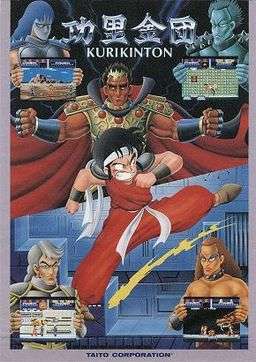Kuri Kinton
| Kuri Kinton | |
|---|---|
 | |
| Publisher(s) | Taito |
| Platform(s) | Arcade |
| Release date(s) | 1988 |
| Genre(s) | Beat 'em up |
Kuri Kinton is a side-scrolling beat 'em up arcade game published by Taito. Players control a Chinese policeman who must dispatch numerous enemies while progressing through the game's levels.
The object of the game is to rescue a senior policeman and his daughter, both of whom have been kidnapped by a gang and spirited away to an underground hideout.
The most interesting thing about this game is that it is freely (and not officially) inspired from two popular mangas of this period:
Dragon Ball, for the main character aspect and powers (can throw kamehamehas and uses a sort of Kaïo-Ken).
Hokuto No Ken, for bosses aspect and technics they use.
Video game adaptations of these two mangas were rare in 1988( apart from NES and Master System), that's why the game was somehow (and is still) popular among a category of players.
The game received though a mixed response from games critics.
Gameplay
Players control a Chinese policeman who has been tasked with infiltrating an underground base to rescue a high-ranking police officer and his daughter, who have been kidnapped by a gang.[1] Play consists of kicking and punching numerous enemies,[2] sweeps and flying kicks can also be used.[1] The game begins in an underground corridor populated by armored soldiers and fighters who throw shurikens.[3] The player must follow the on-screen arrow which points them in the right direction as they proceed deeper into the caves and encounter greater numbers of more deadly enemies.[3] A martial arts expert boss guards the exit of each level and quickly defeat the player-character if not fought carefully.[2]
The player has one life in the game, represented by a health bar which drains as enemies land attacks on the player-character.[2] Should the health bar drain completely, the game is over and a plump golden cherub will rise from the player-character's body. Should the player pay for another credit and continue the game, the cherub will dive back inside the player-character's body, who will in turn jumps to his feet with a shocked expression.[3]
Release
The original arcade game was not released on any computer or console systems of the era.[1] Kuri Kinton was eventually released in 2006 as part of the video game compilation Taito Legends 2,[4] for Windows and the PlayStation 2 and Xbox games consoles and for PlayStation Portable on the compilation Taito Legends Power Up.
Reception
Kuri Kinton has received a mixed response from reviewers and critics. Retrogames' staff member writing in a 2010 feature described the levels as bland, criticised the game's bosses for being effectively the same character with different colored clothes. Despite this, the reviewer stated "..there's something quite fun about the game that makes it difficult to put down..". Kung-Fu Master was suggested as a more readily accessible game with similar gameplay.[1] ACE's Andy Smith was more critical when writing in 1988. He stated "Kuri Kinton's a dull game, the graphics aren't anything special and the game style's very old hat by today's standards."[2] Computer and Video Games' 1989 review was more positive, the reviewer praised the game's "..large sprites and well drawn graphics" and stated "Kuri Kinton packs a hell of a punch and is far more playable than The Last Apostle."[3]
As part of the Taito Legends 2 compilation the game was described as "..fairly standard side-scrolling brawler fodder.." by Eurogamer's Kristan Reed.[5]
References
- 1 2 3 4 "The Unconverted". Retrogamer. Imagine Publishing (80): 84, 85.
- 1 2 3 4 Smith, Andy (November 1988). "Arcades - The Devestation Game". ACE. Future Publishing (14): 85.
- 1 2 3 4 "Arcade Action". Computer and Video Games. EMAP (87): 103. January 1989.
- ↑ Miller, Greg (2007-06-04). "Taito Legends 2 Review". IGN. Retrieved 2010-09-30.
- ↑ Reed, Kristan (2006-03-31). "Taito Legends 2 PlayStation 2 Review". Eurogamer. Retrieved 2010-09-30.